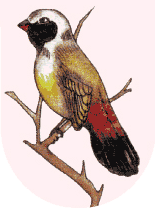
Tuesday, July 27, 2010
Update on Guira Cuckoo
After about two weeks of incubation we noticed egg shells on the floor one morning. When we took a closer look in the nest there was no chick and we realised the egg was discarded from the nest. All the other eggs later proved to be infertile. This is the second time this has happened and we have decided to take the male to a vet for a check-up as it seems that this must be the problem. 

Monday, July 26, 2010
A remarkable recovery :Red Faced Crimson Wing
Yesterday Morning, on inspecting my aviaries,I noticed my Red Faced Crimsonwing cock on the floor in an up right position, but looking very dead. On examination it was found to be still alive (but only just) and quite warm.Being late for an appointment, all I could do was give it a few sips of honey water and place it in a double breeder cage which had a lot of sunshine shining into it.(one of the most important items to treat a sick bird with is applying suitable heat to raise its metabolism)
On Arriving back late in the afternoon fully expecting it to have died I was most surprised to see it very actively flying from perch to perch. It was as though nothing had happened.It is now back in its aviary and full of life.I wonder if anyone else has had a similar experience
On Arriving back late in the afternoon fully expecting it to have died I was most surprised to see it very actively flying from perch to perch. It was as though nothing had happened.It is now back in its aviary and full of life.I wonder if anyone else has had a similar experience
Sunday, July 11, 2010
Guira Cuckoos breeding at Boscia
 The flock of Guira Cuckoos have started incubating a clutch of 6 eggs last week. These South American birds are communal nesters and several females lay in one nest and will help with the incubation. They resemble African Coucals in the way they run on the ground and scuttle between branches. We feed them on day old chicken meat, mealworms and the occasional pinky. Being part of the Cuckoo family the eggs hatch within 12 days and the chicks flegde five to six days later. These birds are very easy to care for and can become very tame.
The flock of Guira Cuckoos have started incubating a clutch of 6 eggs last week. These South American birds are communal nesters and several females lay in one nest and will help with the incubation. They resemble African Coucals in the way they run on the ground and scuttle between branches. We feed them on day old chicken meat, mealworms and the occasional pinky. Being part of the Cuckoo family the eggs hatch within 12 days and the chicks flegde five to six days later. These birds are very easy to care for and can become very tame.
New Avairy for Northern Carmine Bee-eaters at Boscia
Building of a special avairy for the pair of Northern Carmine Bee-eaters we acquired in July 2009 has started a week ago and hope to have it finished within the next two weeks. The avairy is just over six meters wide by five meters long and will be 2.4 meters high. 
In the one corner of the avairy will be a small dam and above it an artifical sand wall in which pipes with nest boxes will be positioned at various positions to act as nesting sites. The paper written on the nest boxes at Animal Kingdom at Disney in Orlando, Florida, USA, was of great help and we hope to replicate their success with breeding this species.
Bester birds imported five pairs about a year ago and we managed to secure one pair. The other four were allready booked for a collector in Malelane, Mpumalanga. We have spoken to Mike Bester about the possibility of importing more birds and we are hoping to get at least another pair soon.
Bester about the possibility of importing more birds and we are hoping to get at least another pair soon.
The Northern Carmine Bee-eaters will share their cage with a pair of Bruce’s Green Pigeons and a pair of Roul-roul Partridges that we got recently.
Updates on the progress on the avairy will be posted regularly.



In the one corner of the avairy will be a small dam and above it an artifical sand wall in which pipes with nest boxes will be positioned at various positions to act as nesting sites. The paper written on the nest boxes at Animal Kingdom at Disney in Orlando, Florida, USA, was of great help and we hope to replicate their success with breeding this species.
Bester birds imported five pairs about a year ago and we managed to secure one pair. The other four were allready booked for a collector in Malelane, Mpumalanga. We have spoken to Mike
 Bester about the possibility of importing more birds and we are hoping to get at least another pair soon.
Bester about the possibility of importing more birds and we are hoping to get at least another pair soon.The Northern Carmine Bee-eaters will share their cage with a pair of Bruce’s Green Pigeons and a pair of Roul-roul Partridges that we got recently.
Updates on the progress on the avairy will be posted regularly.


Subscribe to:
Posts (Atom)
